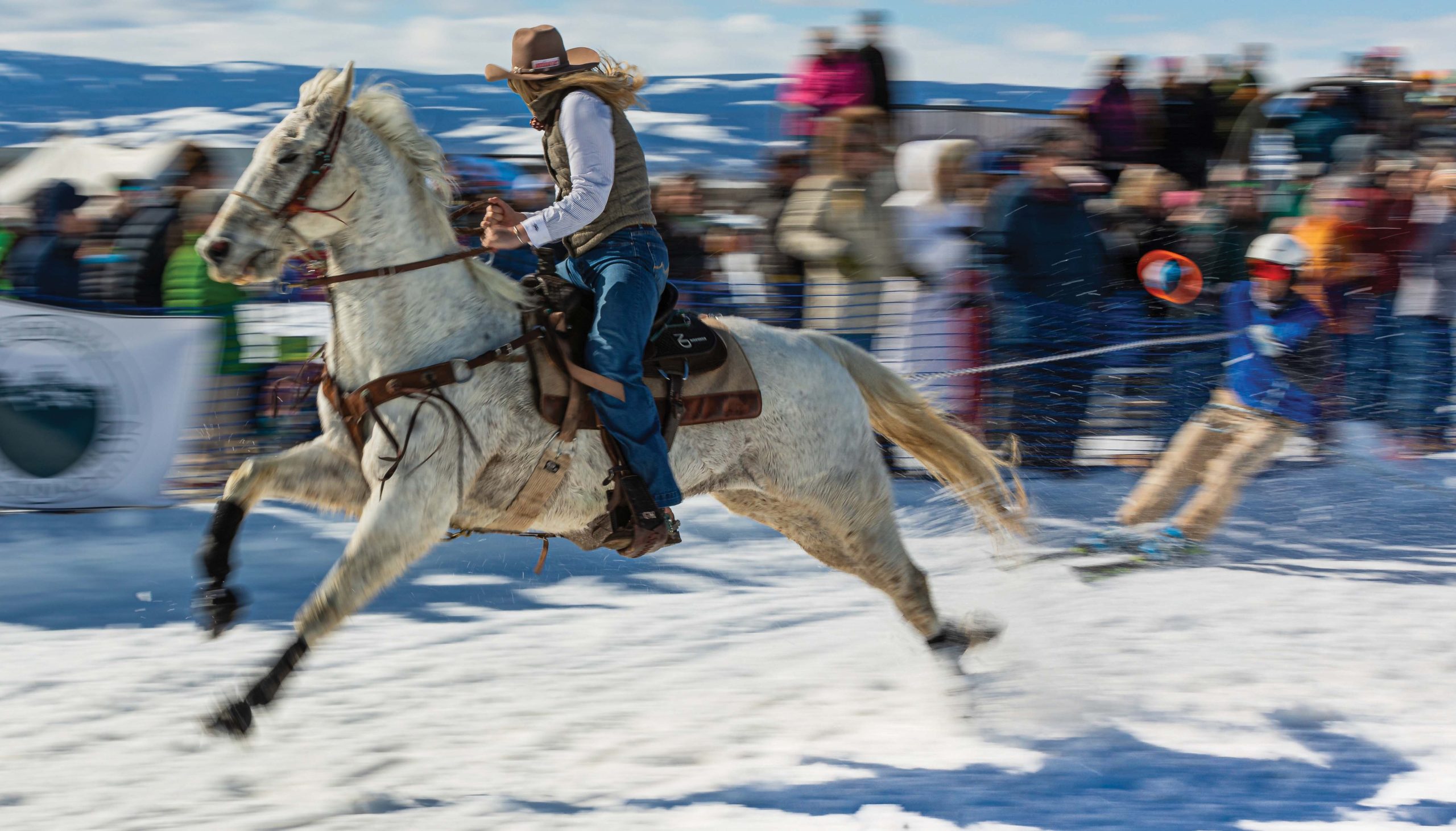
22 Nov IDAHO’S SKIJORING REVIVAL
A horse runs across a snowy field — a rider at the reins — as a skier clings to a rope tethered behind the saddle. The skier leaps off jumps, dodges obstacles, and carves turns while spectators cheer. Skijoring is a sport with rich history in the Mountain West, and it’s recently been brought back to life after a hiatus in a small Idaho community. The revived Teton Valley tradition melds new and old, combining the valley’s ranching heritage with the people’s love of snow sports. This winter, The Grand Showdown skijoring event will take place in Driggs, Idaho on February 22 and 23, 2025.
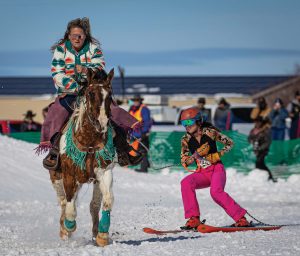
The rapidly growing women’s-only division is popular with contestants and spectators.
“It’s one of the most exciting spectator sports there is,” says Neal Stobaugh, founder of Teton Valley Skijoring, who adds that pro division runs are super fast. “It’s just 19 seconds of action. It’s a race course, and you’re going back and forth through gates, you’ve got to get a ring or two, and the horses add an element of excitement. Rarely do you get cowboys and skiers in the same room … but [with skijoring] they come together, and that makes it even more exciting.”
The sport originated in Scandinavia, and organized skijoring appeared at the 1928 Olympics in Switzerland as a demonstration sport. Now, a circuit of competitions is held annually throughout the Mountain West, and some races occur internationally in Canada and Europe.
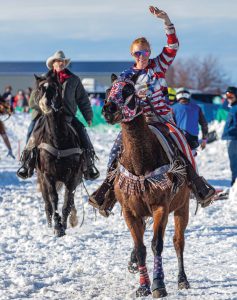
Fan favorite Tayler Stobaugh of Big Sky, Montana attempts to get the crowd involved.
Stobaugh says skijoring had a presence in the Teton Valley on and off for around 20 years, with events held in Driggs, Victor, or nearby Jackson, Wyoming. He says most spectators and competitors were fairly local. After the event was canceled two years in a row — in 2017, a fierce windstorm toppled 17 power poles along Teton Village Road just days before the event, leaving areas without power for a week, and 2018 brought about a winter too warm for skijoring — interest in organizing the competition waned. The event disappeared for a few years before returning in 2023.
Inspired by skijoring held in Big Sky, Montana, Stobaugh wondered why the Teton event had been discontinued, and he started asking around. Recently retired, he decided to form Teton Valley Skijoring, a nonprofit that organizes a local skijoring event once again, and recruited five others to work with him to turn the concept into reality. Together, they brought the revitalized event back to give people something fun to look forward to during the snow season while boosting the winter economy. They aim to preserve the area’s Western heritage and share funds collected with other valley nonprofits, including mental health organizations.
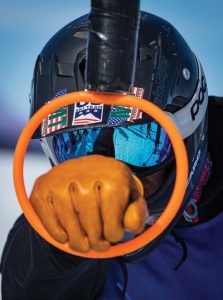
A skier eyes up an approach angle for a ring catch.
Organizers estimate that several thousand people attended the inaugural 2023 event. Stobaugh says 2024 brought in 150 teams to compete in six divisions — including one for snowboarders — bringing as many as 6,000 spectators over the weekend. He anticipates the 2025 event will see even more.
Stobaugh credits part of this rapid growth to the national attention the sport has received in recent years, including a spot on NBC’s The Kelly Clarkson Show featuring Stobaugh’s daughter, Tayler, who is known for competing in her distinctive red-white-and-blue garb. Also known as “Captain America,” Tayler appeared on the talk show with skier Colter Fretwell and their equine partner, Little Bo Peep.
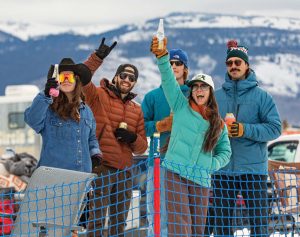
Trackside tailgating is a big part of the skijoring experience for fans.
Tayler started skijoring just six years ago, and she has been both rider and skier, though she prefers to be atop her horse. She lives in Big Sky, where she manages a ranch. During her first year of skijoring, she attended just two or three events, but now she’s competing almost every weekend in the winter. Since events are so geographically spread out, she finds herself home only a couple of days a week during competition season, which typically runs from January to March and includes events in Colorado, Montana, Wyoming, Utah, and Idaho.
She didn’t originally plan on wearing patriotic gear during every competition; she had been wearing typical Western attire to each event until the day she faced a wardrobe malfunction. “I was getting on my horse, and my jeans split, so I ran to my horse trailer, and I had these American flag leggings in there,” Tayler says. “I had just bought an American flag hoodie, so I put that on, too, and as soon as I [rode out dressed patriotically], the crowd went wild.”
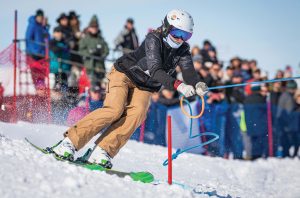
A contestant navigates a gate while clutching a ring. Dropping the ring before crossing the finish line would be an assessed penalty.
Later, as she traveled to another competition, the event organizers called and asked if she was wearing her outfit again. “I was like, ‘Uh, what outfit?’” she says with a laugh. It wasn’t long before she found herself adding a variety of American-flag-themed pieces to her wardrobe, and she quickly became known for skijoring in red, white, and blue.
Tayler’s favorite part of competing is the camaraderie she’s developed with fellow participants. “If it wasn’t for this community, I probably wouldn’t be doing it. They are so supportive. Even your biggest competitor is standing at that start line with you and cheering you on, even though you’re trying to beat them and they’re trying to beat you. It’s like we’re one big family when we’re together.”
Succumbing to the thrill-seeker inside, she adds, “I also love running my horse fast, so that’s one added bonus.”
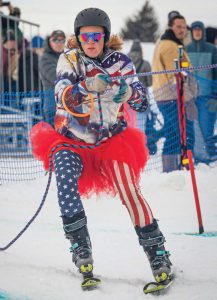
A big hit with the spectators, creative dress and thematic costumes are becoming increasingly common and run the gamut, from Western to patriotic to downright silly.
While humans receive much of the attention, skijoring couldn’t happen without the equine team members. Julie Martin, executive director of the horse rescue and adoption nonprofit HAPI Trails, has been involved with skijoring events since 2010 and is a committee member for Teton Valley Skijoring. Through her organization, Martin works to ensure the horses are well cared for during the event, which includes posting veterinarians on-site. She says with 150 teams, there are typically around 125 horses. Some people bring several horses and race them in different divisions, and each horse is allowed to run a maximum of two races per day — though a third race is allowed if it’s slower, such as pulling a snowboarder or the junior division. Martin delights in watching the horses, who clearly enjoy the sport’s thrill.
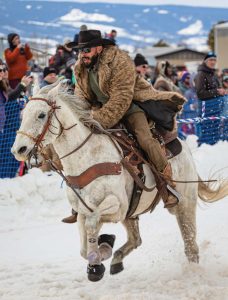
Contestant attire serves multiple purposes — warmth, entertainment, and expression of style.
Her favorite part is “seeing horses do something that they really love,” Martin says. “But it’s also just getting my community involved. I love seeing people utilize their horses outside of their normal realm. You’ve got barrel racers, trail riders, wranglers, ropers, and they’re all using their horses in a way that they wouldn’t normally, expanding on that Western heritage of use.”
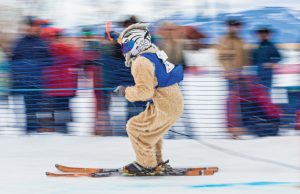
A competitor dressed as a Yeti streaks through a spray of snow during the run.
A lot happens behind the scenes before spectators come out to see a weekend of racing — from course building to competitor preparations and everything in between. It can be intimidating for new participants to try the sport for the first time in front of a sizeable crowd, so Teton Valley Skijoring and HAPI Trails team up to offer a few practice weekends during the winter where people can try their hand at skijoring without the pressure of hundreds — or thousands — of spectators watching their every move. Providing low-stress opportunities to try out the sport has led to a surge in participation in the novice and junior divisions.
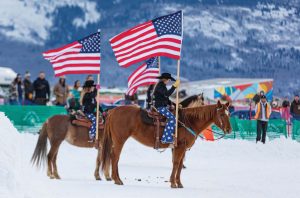
Events typically open in patriotic fashion, including a procession of flags and singing or playing of the national anthem.
Stobaugh is excited that more people are trying skijoring since it’s such a great blend of Teton Valley’s Western heritage and world-class snow sports. “We have so many equine properties, lots of horses, lots of cowboys and cowgirls,” he says. “We’ve got the summer rodeo here. And it’s kind of a winter rodeo. And then, on top of that, we have world-class snow at [Grand Targhee Resort], so we have some of the best snowboarders and skiers in the world. It’s a perfect sport for the Teton Valley.”
Kristen Pope is a freelance writer and editor who covers stories about mountain living, science, conservation, travel, and the outdoors for a number of outlets; kepope.com.
Mark LaRowe specializes in Western lifestyle, landscape, and portraiture photography. He has covered rodeos for 13 years and is an eight-time Northern Rodeo Finals photographer. He has also photographed nearly 40 skijoring events over the course of his career. Currently serving as president of the Montana Professional Photographers Association, LaRowe lives north of Helena, Montana.




No Comments